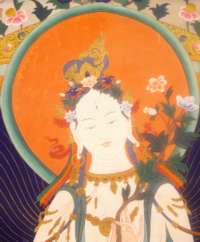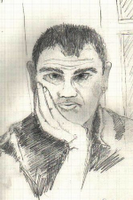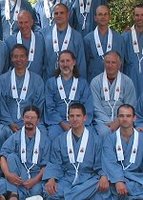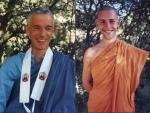- for Pema Yutso
 Buddhism can seem a bit dour at times, and indeed Buddhists are often accused of negativism or pessimism. It is true that the inevitability of suffering is of central interest and importance, however, as Sangharakshita has pointed out (in A survey of Buddhism) this interest is actually methodological. We use suffering as a starting point for reflection because it really is universal, and because it is experiential rather than conceptual. So suffering is something that everybody can relate to, and we don't get bogged down in definitions. Suffering also motivates us to change!
Buddhism can seem a bit dour at times, and indeed Buddhists are often accused of negativism or pessimism. It is true that the inevitability of suffering is of central interest and importance, however, as Sangharakshita has pointed out (in A survey of Buddhism) this interest is actually methodological. We use suffering as a starting point for reflection because it really is universal, and because it is experiential rather than conceptual. So suffering is something that everybody can relate to, and we don't get bogged down in definitions. Suffering also motivates us to change!But as everybody knows life is not 100% suffering. There are moments of relief, of pleasure, gratification and satisfaction, moments even of grace. We Buddhists harp on about old age, sickness and death, but there is also birth, growth, renewal and wellness at times. The central plank of all Buddhist philosophy - paticca-samuppada in Pali or pratitya-samutpada in Sanskrit - is variously translated as 'dependent arising, or conditioned co-production'. This suggests to me that even though we tend to focus on the passing away aspect of reality, that the arising or coming into being of things is really very important.
Any given event is the result of the collision of an immense, perhaps infinite, number of factors which adhere and coalesce to give a sense of something coming into being. And this means that the coming into being is completely mysterious, that the arising of feelings like, say, anger or grief are not ultimately reducible to a single cause - if we are angry or sad there will have been a number of causes which include a predisposition to that emotion which we can by no means blame on our friend!
The trouble is that we get lulled into a false sense of knowing by the seeming reliability of the world. The laws of physics always apply in the world. So we think we understand what is happening when things fall to the floor - that is gravity, and when you let go of something it falls. The physical fact of gravity is a constant, but we tend to isolate it when we think about events. So we can get trapped by this apparent reliability and fail to observe that most of the event was completely unpredictable. For instance if someone drops our favourite cup and it breaks then our reaction can be completely changed by how we were feeling at the time, or whether we had a good nights sleep the night before, whether the cup was full of liquid etc, etc. One day we might pass over it as an unfortunate accident, and the next it will seem like a major catastrophe. If one person drops our cup we immediately forgive them, if it is someone else we may hold a grudge for years. As predictable as the physical world is, our subjective inner world is unpredictable.
It is good to notice how the process of arising is going on all the time. If you watch it then you can easily see how your attention flits about like a butterfly between the senses, and between objects in any one sensory field. Each time we become aware of an object of the senses - something arises in our minds. If you sit in a room for an hour then not much may change - the furniture doesn't usually spontaneously move or fall apart - but our attention is constantly moving and flicking from one object to the next so that we are constantly changing our focus and something new is arising. We live immersed in a number of sensory fields which present a constant flux of impressions - sights, sounds, smells, touches, tastes, and from the Buddhist point of view thoughts, memories, associations, judgements, and emotions. Each time we take in a mote of sensory data there is a cascade of responses that are mostly out of our control. We do this so many times a second that it seems that, rather than a series of discreet moments, that there is a continuum, and that there is someone watching the play of the senses making 'sense' of of it all. But this is an illusion just the way that 25 frames per second of film images projected onto a screen gives us the impression of smooth movement when watching a film.
It can be a bit depressing to focus on the passing away aspect of reality. Especially when a friend is, for instance coping with the impending death of a parent, or feeling depressed. Yes things are always passing away, yes we ourselves with pass away, but look... every moment something arises, even if only within our own minds. There is so much arising going on! Every moment there is something new in our awareness, and that means that every moment contains the potential for freedom!
Not only this but paticca-samuppada comes in two flavours. In one there is a cycling between opposites - pleasure/pain, birth/death. In the other things build up. A acknowledgement of suffering leads to faith, which leads to joy, which leads to happiness which leads to rapture etc until one thing leads to another and one is liberated. Usually we think of freedom from suffering as a result of removing the causes of suffering. What this second type of paticca-samuppada tells us is that freedom from suffering also arises in dependence on causes. If it did not, then we could never escape from suffering. This is the Buddhist equivalent of "The Good News" - we can help to set up the conditions for the arising of freedom from suffering.
So next time you have a moment, just notice all the many things which are arising in your awareness, or the new things coming into being, and have a little celebration. Although at times that arising seems chaotic and out of control, it is that very arising which means we that we can experience the Deathless state. It is always good to be aware of what we are paying attention to, and to exercise such choice as we have in the matter, and to develop that ability to choose, but there's no law that says that because we are Buddhists we must focus on the depressing aspects of life. Yes, there are those kinds of practices, but it's a matter of appropriateness and applicability. It's OK to focus on the coming into being aspect of the world at times.














 Sangharakshita spent nearly twenty years living in India, was ordained as a bhikkhu, and had plenty of opportunity to observe modern day bhikkhus. And what he saw was a lot of men going through the motions, shaving their heads, wearing robes, and refraining from meals after noon, but not actually attempting to Awaken. Although there may have been exceptions, formalism seems to have been the rule. We get a hint of why from Peter Masefield, an academic and Theravidan Buddhist, in his book Divine Revelation in Pali Buddhism, where he concludes that without the direct intervention of a Buddha that Awakening is impossible, and within a generation of the Buddha's parinibbana Arahants would have died out. Actually Masefield, despite his voluminous citations, has overlooked a vast number of examples which contradict his conclusions and the book is deeply flawed, although still in print. But if Awakening is not possible, then what is the point? The Tibetan Buddhists that Sangharakshita met did seem to have a living Buddhism. Despite the fact that many of them were not following the vinaya to the letter, or at all, they had a depth of practice that inspired Sangharakshita.
Sangharakshita spent nearly twenty years living in India, was ordained as a bhikkhu, and had plenty of opportunity to observe modern day bhikkhus. And what he saw was a lot of men going through the motions, shaving their heads, wearing robes, and refraining from meals after noon, but not actually attempting to Awaken. Although there may have been exceptions, formalism seems to have been the rule. We get a hint of why from Peter Masefield, an academic and Theravidan Buddhist, in his book Divine Revelation in Pali Buddhism, where he concludes that without the direct intervention of a Buddha that Awakening is impossible, and within a generation of the Buddha's parinibbana Arahants would have died out. Actually Masefield, despite his voluminous citations, has overlooked a vast number of examples which contradict his conclusions and the book is deeply flawed, although still in print. But if Awakening is not possible, then what is the point? The Tibetan Buddhists that Sangharakshita met did seem to have a living Buddhism. Despite the fact that many of them were not following the vinaya to the letter, or at all, they had a depth of practice that inspired Sangharakshita.
